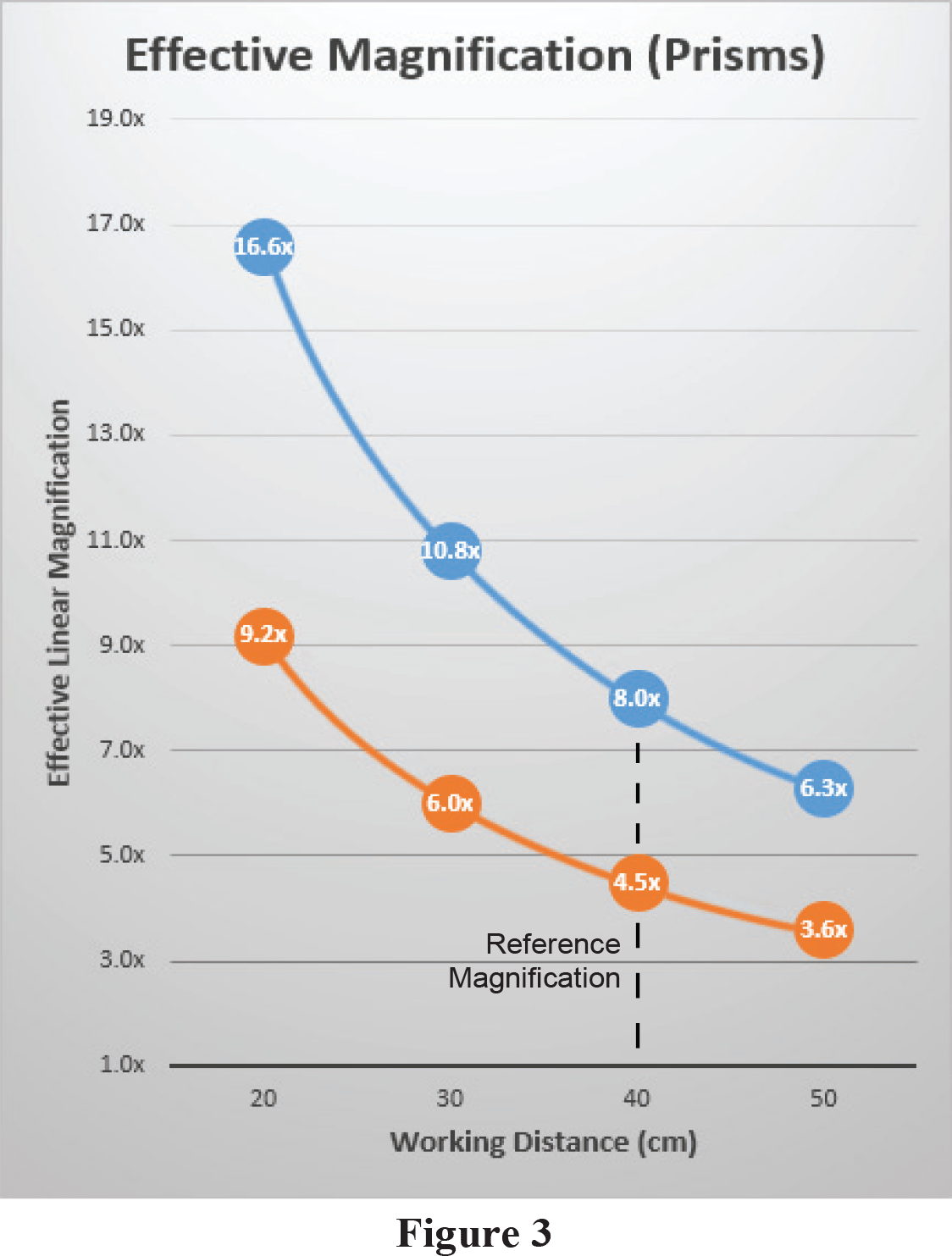Magnification Power as the Key Vision Factor, Key Factors for Ordering Custom Loupes: Part 2

ErgoPractice News – May 2014
By Jin Chang PhD
jchang@surgitel.com
There are two main benefits of using loupes. The first is to improve our working posture: to avoid work-related pain and injuries.1 The second is to improve our vision: to see the details of our work.2-3
The key ergonomic factor for loupes is the declination angle. We showed how to determine the optimum declination angle for your next pair of custom loupes in the April issue of ErgoPractice News. The key vision factor for loupes is the magnification power. In this May issue, we will help you decide the magnification level of your next pair of custom loupes by answering key questions about loupe magnification powers.
The key questions we will answer are:
- Visual Acuity: How can we improve our vision?
- Resolution vs Magnification: Which is more important?
- Reference Magnification and Effective Magnification: How can we rate magnification power?
- 2D Magnification vs 1D Magnification: Which better represents visual perception?
- Trends in both average working distance and magnification power: Can 2.5x power loupes truly continue to be the standard magnification power of beginner’s loupes?
Visual Acuity: How to Improve Our Vision?
If line separation (LS) is a measure of the level of detail our eyes can perceive, LS can be determined by a formula as a function of working distance (WD) and magnification power (MP) of telescopic loupes:4
LS = 3.3 x WD/MP,
where LS is in µm and WD is in cm.
According to this formula, we can improve our vision in two ways. The first way is to reduce our working distance, which can be done simply by leaning in very close to an object (Figure 1b). This is more instinctual to us than using a tool such as loupes. The other way is to increase our magnification power (up from 1x with no loupes) with which we can maintain an ergonomic, upright position (Figure 1a). The two students in Figure 1 may be achieving similar visual acuity as the image size of an object formed on the retina by both ways is similar. The main difference is their working distances and working postures. If the student ‘a’ maintains this ideal posture, she will have a long and healthy career. If student ‘b’ continues to work like this, she may suffer neck and upper back pain and injuries in a very short time.

Resolution Vs. Magnification: Which Is More Important?
Resolution indicates the sharpness of images and magnification indicates the enhanced size of the perceived image of an object. Loupe selection guides by some loupe manufacturers indicate that resolution is more important than magnification. But actually, both resolution and magnification are equally important because our eyes have a limited resolving ability. Even if loupe optics form images with an infinite resolution, our eyes cannot see beyond a certain level of detail. The image needs to be “brought closer” to our eyes through magnification to take advantage of a good image resolution.
It should be noted that no matter the resolution of individual ocular lenses, the experienced resolution of a binocular optical system strongly depends on the alignment of the two oculars. Precision alignment depends on the sturdiness of frames for Through-The-Lens (TTL) loupes and the stability of ocular mounting rack/arm assembly for Front-Lens-Mounted (FLM) loupes. Most major loupe manufacturers are able to make individual oculars with a good resolution, but if the alignment of two oculars is not precise, the resulting image resolution is poor. As magnification power increases, frames and rack/arm assemblies need to be even sturdier and more stable. It is very important to always consider frame quality for TTL loupes and the stabilizing features of rack/arm assembly for FLM loupes.
Reference Magnification and Effective Magnification
 As a loupe’s working distance changes, the magnification power of the loupe changes. Because of this, the Reference Magnification quoted by the manufacturer refers to a specific focal distance. At a closer or farther working distance than this reference point, the experienced magnification may be greater or less than the reference magnification.
As a loupe’s working distance changes, the magnification power of the loupe changes. Because of this, the Reference Magnification quoted by the manufacturer refers to a specific focal distance. At a closer or farther working distance than this reference point, the experienced magnification may be greater or less than the reference magnification.
For example, 2.5x loupes offered by various manufacturers may not have the same magnification power because reference focal distances used by manufacturers are not the same. Since some companies may even use unrealistic reference points to enhance their quoted magnification level. You should not rely entirely on the reference magnification powers quoted by manufacturers. One of the most effective magnification tests you can do is simply compare loupes using a test target. Doing this you can compare magnification power as well as resolution (image sharpness).
 One of your objectives of using loupes is to improve vision. As pointed out earlier, we can improve our vision by getting closer to objects. The result is that the projected image of an object onto our retina will be enlarged by reducing our distance. The same principle can be applied to the use of loupes.
One of your objectives of using loupes is to improve vision. As pointed out earlier, we can improve our vision by getting closer to objects. The result is that the projected image of an object onto our retina will be enlarged by reducing our distance. The same principle can be applied to the use of loupes.
The Effective Magnification of your loupes compared to the Reference Magnification may be very different. This is because your working distance is most likely different from the reference distance at which the magnification power was computed. The image size of objects projected onto the retina will enlarge or shrink as the working distance changes.
Figure 2 shows the effective magnification of a Galilean loupe with a reference point at 40cm (near 16 inches) for 2.5x magnification. At 30cm (near 12 inches) the effective magnification of this loupe is 3.4x and at 50cm (near 20 inches) the effective magnification is 2.1x. Figure 3 shows the effective magnification of several working distances for two prism loupes with reference points at 40 cm (near 16 inches). You can see, as the working distance decreases the effective magnification power increases significantly.
2D Magnification Vs. 1D Magnification
 The two-dimensional (2D) magnification is given by the square of one-dimensional (1D) magnification (Figure 4). The 2D image size obtained with a 2.5x loupe will be 6.25 times of the image obtained with unaided eyes and the 2D image obtained with an 8.0x loupe will be 64 times the image obtained with unaided eyes. The information obtained with the 8.0x loupe is more than 10 times of the information obtained with the 2.5x loupe. As you can see, the 1D measurement does not indicate the reality of the 2D increase in image detail. Although the 1D magnification has been used to rate loupes, 2D magnification may be the true presentation of the visual perception improved through the use of loupes.
The two-dimensional (2D) magnification is given by the square of one-dimensional (1D) magnification (Figure 4). The 2D image size obtained with a 2.5x loupe will be 6.25 times of the image obtained with unaided eyes and the 2D image obtained with an 8.0x loupe will be 64 times the image obtained with unaided eyes. The information obtained with the 8.0x loupe is more than 10 times of the information obtained with the 2.5x loupe. As you can see, the 1D measurement does not indicate the reality of the 2D increase in image detail. Although the 1D magnification has been used to rate loupes, 2D magnification may be the true presentation of the visual perception improved through the use of loupes.
Digital cameras use a measure called Megapixels which counts the total pixels, or points of detail, recorded. This is an example of a 2D measurement as it is obtained by multiplying details in the height and width.
Trends In Average Working Distance and Magnification Power
As a result of better ergonomic education, more clinicians are sitting or standing with a much straighter back and neck positions. As a result, we have noticed that the average working distances of dental professionals has significantly increased over time. Our data indicates that the average working distance of dental professionals has increased from about 15 inches a decade ago to more than 18 inches today. Many dental students and hygiene students even decide to work at more than 20 inches. The increased working distance helps with ergonomics and may even reduce cross-contamination, but 20 inches simply requires a higher magnification power to see the same level of detail seen at 15 inches.
2.5x loupes have been widely recommended for dental professionals as a starting magnification. Can 2.5x loupes continue to be an industry standard with working distances increasing as they are? The answer is definitely No: we need more magnification. If the working distance increases 15 inches to 18 inches or 20 inches, the magnification power should increase from 2.5x to 3.0x or 3.4x+.
Several dental schools have started to recommend 3.0x or 3.5x loupes to their students as startup loupes, skipping 2.5x all together. Based on the working distance trends, their recommendation is well justified. And since the field of view of Galilean loupes with powers higher than 3.0x becomes prohibitively small, prism loupes are recommended for 3.5x or higher magnification.
SurgiTel’s Innovations for Adjustment of Working Distance
You may wish to use different working distances or different magnifications to perform various procedures. So SurgiTel invented two concepts to create multiple working distances and the resulting magnification powers on one pair of loupes. The first are working distance adjustment caps which can change the working distance of Galilean loupes. The second are interchangeable working distance caps (about 10 inches to more than 25 inches) which work for Keplerian (prism) loupes.
Working distance caps are used to:
- Optimize the working distance for different procedures.
- Restoring the original working distance if the users’ eyes change (and require a different reading prescription).
- Increase the effective magnification power to see more details.
The reason loupes are not infinitely adjustable by working distance change is that as working distance changes, inter-pupillary distance changes. So the range of working distance adjustment with TTL loupes is limited more than FLM loupes because the inter-pupillary distance cannot be adjusted with the TTL style. Reducing the working distance is less limited than increasing the working distance. If you intended to use your loupes with several different working distances, we recommend you order your custom loupe with the longest intended working distance.
Advances Made in SurgiTel’s Prism Loupes
Prism loupes are becoming more popular not only for precision procedures but also for beginner loupes. In the past, these options were limited because traditional prism designs have several drawbacks: long length of oculars and heavyweight. To overcome these problems, SurgiTel invented a new design concept (patented) which significantly reduced the length of oculars and created the compact line of prism loupes. Recently, SurgiTel introduced micro-line prism loupes (3.0x, 3.5x, 4.5x) which are even lighter than traditional Galilean loupes. In addition to these improvements, SurgiTel invented the interchangeable working distance caps which allow a loupe to have multiple working distances of about 10 inches to more than 25 inches.
Questions and Answers
Question #1: I am a dental student, who is 6 feet tall, and my working distance is about 20 inches. What magnification power do you recommend?
Answer: One can recognize a 50µm line separation at 15 inches using 2.5x power loupes. If you want to recognize the 50µm line separation at 20 inches, you will need more than 3.3x power loupes. So we recommend 3.5x or higher prism loupe. Recently several dental schools started to recommend 3.5x or higher prism loupes as standard for all students at all working distances.
Question #2: I am a veterinarian. My practice includes both surgical and dental procedures. My optimum working distance with dental procedures is several inches shorter than surgical procedures. Can I use the same loupe for both procedures?
Answer: The answer is yes. You can adjust the working distance of your loupe with working distance caps. You may order your next custom loupe for the surgical procedures and a pair of working distance caps for the dental procedures. Using the working distance caps you will not need to compromise your working posture during any of your procedures.
Question #3: I am a general dentist and perform various procedures, including endodontic procedures. I have used a 2.5x loupes for the last five years. Several friends told me that I should upgrade to a higher power loupe. What power loupe do you recommend?
Answer: Many of our current customers have been upgrading to a high-power prism loupes such as 3.5x or 4.5x and later some of them to up to 8.0x. I recommend 3.5x or 4.5x as your first upgrade. It should be noted that recently several dental schools started to recommend 3.5x prism loupes to their students. With your 2.5x loupes, you can achieve an improved working posture, but you do not experience the true benefits of magnification.
References:
- Rucker, Lance M. “Surgical magnification: posture maker or posture breaker.” Ergonomics and the dental care worker. Washington, DC: American Public Health Association (1998): 192-206.
- Leknius, C., and M. Geissberger. “The Effect of Magnification on the Performance of Fixed Prosthodontic Procedures.” Journal of the California Dental Association 23, no. 12 (December 1995): 66–70.
- Kanca, J., and P. G. Jordan. “Magnification Systems in Clinical Dentistry.” Journal (Canadian Dental Association) 61, no. 10 (October 1995): 851–52, 855–56.
- Chang, Jin. “How to Determine Your Custom Magnification Needs.” SurgiTel. SurgiTel, May 1, 2014. https://www.surgitel.com/how-to-determine-your-custom-magnification-needs/.



